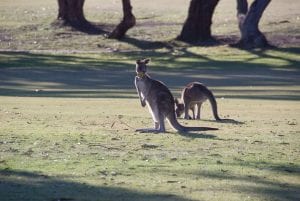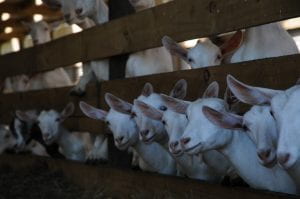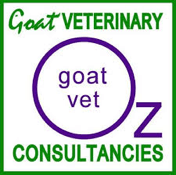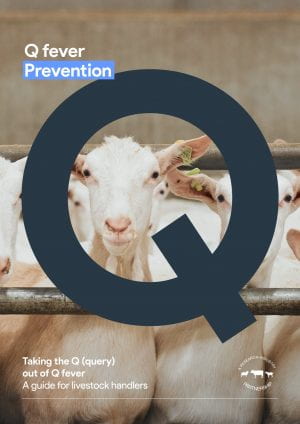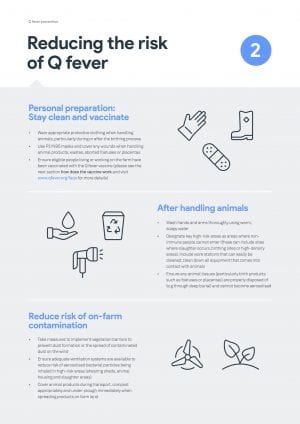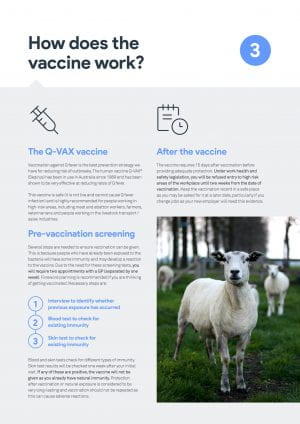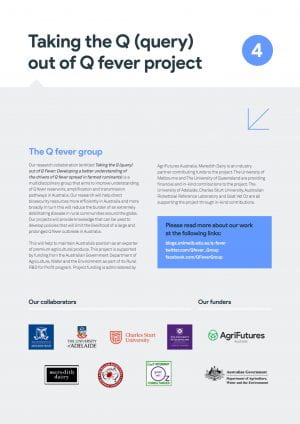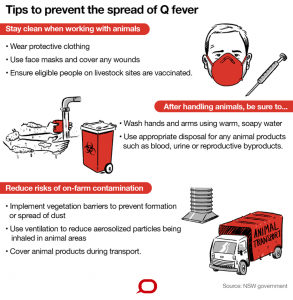About
Taking the query out of Q fever is a multidisciplinary research-industry group that aims to improve understanding of Q fever reservoirs, amplification and transmission pathways. Our research will help direct biosecurity resources more efficiently in Australia and more broadly. In turn this will reduce the burden of an extremely debilitating disease in rural communities and around the globe.
Developing a better understanding of the drivers of Q fever in farmed animals
This project will provide knowledge that can be used to develop policies that will limit the likelihood of a large and prolonged Q fever outbreak in Australia. This will help to maintain Australia’s position as an exporter of premium agricultural produce.
The overall objectives of our research are to:
- develop a better understanding of factors influencing the risk of Q fever spread within and between Australian ruminant livestock enterprises
- develop national guidelines for an emergency response plan to be used in the event of future Q fever outbreaks in humans
What is Q fever and how is it spread from animals to humans?
Q fever (or coxiellosis) is an infectious disease of humans and animals caused by the bacteria Coxiella burnetii. While many people infected are asymptomatic or develop only mild symptoms, for others, Q fever can cause a prolonged, debilitating illness. Some affected individuals will also develop chronic syndromes that can include endocarditis, osteomyelitis and vascular disease. 10-15% of cases can also develop a chronic fatigue syndrome. Further information on Q fever in humans is available here. In animals, coxiellosis often goes undetected, however infection with Coxiella burnetii can cause reproductive and production losses.
Intensively managed livestock herds provide conditions favourable for amplification and spread of Q fever. C. burnetii is extremely resistant to environmental conditions and is one of the most contagious organisms known to man: a single organism is sufficient to cause infection. The most common route of infection is inhalation of contaminated dust, though contact with contaminated milk, meat, wool and close contact with infected animals, particularly their birthing products, also pose risks of infection.
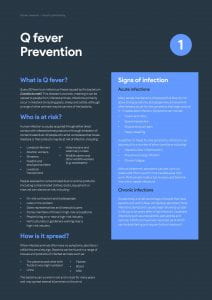
The risk of Q fever outbreaks in Australia
In The Netherlands in 2007-2010 there was a large outbreak of Q fever in humans, with 4000 confirmed cases and 30 deaths. Dairy goat herds, infected with Q fever, were the source of this outbreak. There is a risk that an outbreak of Q fever, similar to that which occurred in The Netherlands, could occur in Australia. We have some of the highest rates of human infection in the world, and our combination of conducive climate conditions and growing livestock industry makes us susceptible to possible outbreaks.
To find out more about our research, please navigate this website and don’t hesitate to contact us if you have questions. You can learn more about Q fever in Australia by reading the project’s Q Fever Prevention informative booklet, listening to the excellent ABC Landline podcast series or by viewing other useful fact sheets on transmission, diagnosis and treatment.
The One Health modelling of Q fever outbreaks in Australia is a new project being undertaken by The University of Melbourne, based on a scoping consultancy that identified key gaps in the existing literature and highlighted the need, as well as the potential benefits, of undertaking detailed outbreak modelling. This project is funded by CSL Seqirus.
We invite individuals interested in contributing to or engaging with this initiative to submit their contact details by clicking the button below:
Project collaborators
Melbourne Veterinary School (Veterinary Epidemiology @ Melbourne):
A/Prof Simon Firestone (Project Leader)
Professor Mark Stevenson
Dr Christopher Baker
Dr Patricia Campbell
Dr Ayesha Salgadu
Matt Wenham
Ann Nguyen
Emmy Said
Here you can catch up on the latest news from our own research and engagement as well as other Q fever related news from around the world. Please feel free to contact us if you come across other important and relevant news articles about Q fever that you’d like us to cover.
Click to scroll to news item
Q Fever Group in the media
Other Q Fever Group news
General Q Fever news
Q Fever Group in the media
Multiple ‘Taking the Query out of Q fever’ (Q Fever Group) members published an article in The Conversation that summarises how Australia’s ongoing drought could be increasing the risk of Q fever transmission. They used evidence that Coxiella burnetii spores are very resilient and able to survive in soil or dust for many years to conclude that this bacteria can spread very far during drought, even attaching to dust and travelling 10km or more on winds. This bacteria is also resistant to dehydration and UV radiation, making Australia’s mostly dry climate a very hospitable breeding ground.
Q Fever Group member Associate Professor Jane Heller of Charles Sturt University was interviewed by The Land, a news outlet whose principal aim is to convey news items and relevant information to people whose life and work revolve around agriculture in rural Australia. A/Prof Heller discussed how our industry-research partnership is designed to address major research gaps in Q fever knowledge and help to form a national guideline for an emergency response, should the need arise. Further insight from A/Prof Heller is available in this Queensland and Country Life article.
Q Fever Group member Dr Tabita Tan from The University of Melbourne was interviewed by Dairy News Australia. In this article, Dr Tan explains how high rates of Q fever infection in livestock herds can persist, even without obvious signs of any symptoms in the animals. Dr Tan states that the annual cost of Q fever to the cattle industry amounts to at least $1 million in lost productivity, medical expenses and potential litigation, though this is likely to be a conservative understatement.
Dr Tan also promoted public engagement in Q Fever Group research into Q fever patient experiences in six print media articles – Beef Central, The Rural, Riverine Herald, Country News, Shepparton News and Graham Centre for Agricultural Innovation, as well as being featured through the Rural R&D for Profit Program Researcher Spotlight.
Q Fever Group member Associate Professor Jane Heller highlighted the findings of the project, including the need for greater awareness among veterinarians and human health professionals on Q Fever diagnosis and management in several industry articles – Beef Central and Sheep Central.
Other Q Fever Group news items
- Research collaborator Associate Professor Jane Heller presented about the need for a One Health approach to the management of Q fever at the Australasian Society for Infectious Disease Zoonoses Virtual Conference:
- Heller, J., 2021. Considerations and challenges associated with developing a national Q fever response plan. Australasian Society for Infectious Diseases Q Fever Updates webinar, 29 Sept 2021
- Members of the research collaboration presented their findings at the virtual International Epidemiology Association World Congress of Epidemiology 2021:
- Hou, K., Firestone, S., Wiethoelter, A., Stenos, J., Lignereux, L., Clark, N., Aleri, J., Magalhães, R. and Stevenson, M., 2021. 890 The prevalence and risk factors for Coxiella burnetii on commercial dairy goat farms in Australia. International Journal of Epidemiology, 50(Supplement_1), pp.dyab168-289. https://doi.org/10.1093/ije/dyab168.289
- Abeykoon A.M.H., Hou, K., Vincent, G.A., Stevenson, M.A., Firestone, S.M. and Wiethoelter, A., 2021. 897 Environmental contamination of Coxiella burnetii in and around an endemically infected goat farm. International Journal of Epidemiology, 50(Supplement_1), pp.dyab168-007. https://doi.org/10.1093/ije/dyab168.007
- Tan, T. and Heller, J., 2021. 917 Stakeholder analysis to develop a national outbreak response plan for Q fever in Australia. International Journal of Epidemiology, 50(Supplement_1), pp.dyab168-647. https://doi.org/10.1093/ije/dyab168.647
- Rahaman, R., Burgess, T., Milazzo, A., Marshall, H., Chaber, A.L., Crabb, D. and Bi, P., 2021. 585 Do Australian livestock farmers perceive Q fever prevention differently from animal science and veterinary students?. International Journal of Epidemiology, 50(Supplement_1), pp.dyab168-553. https://doi.org/10.1093/ije/dyab168.553
- Q Fever Group RHD student, Hasanthi Abeykoon presented her research findings at the World One Health Congress (virtual edition) in November 2020:
- Abeykoon A.M.H., Hou K., Clark N.J., Magalhaes R.J.S., Vincent G.A., Stevenson M.A., Firestone S.M., Wiethoelter A., 2020. Environmental sampling to detect Coxiella burnetii: A systematic review and field sampling in an endemic setting. Virtual Poster, World One Health Congress 2020
- Member of the project’s collaborator team shared Q fever knowledge at the 2019 Annual Meeting of the Australian & New Zealand College of Veterinary Scientists:
- Heller, J., Tan, T., Hayes, B., Firestone, S., Stevenson, M., 2019. Responding nationally to a Q Fever outbreak – can we create a plan? In: 2019 Australian & New Zealand College of Veterinary Scientists Science Week Conference Proceedings, Gold Coast, 4-6thJuly 2019, p. 35.
- Hou, K., Firestone, S., Wiethoelter, A., Stenos, J., Lignereux, L., Clark, N., Stevenson, M., 2019. A cross-sectional study of prevalence and risk factors for Coxiella burnettii on dairy goat farms in Australia. In: 2019 Australian & New Zealand College of Veterinary Scientists Science Week Conference Proceedings, Gold Coast, 4-6thJuly 2019, p. 37.
- Abeykoon, A.M., Clark, N., M, Magalháes, R.J.S, Vincent, G., Stevenson, M., Firestone, S., Wiethoelter, A., 2019. Sampling methods to detect Coxiella burnetii in the environment: a systematic review and critical appraisal of evidence. In: 2019 Australian & New Zealand College of Veterinary Scientists Science Week Conference Proceedings, Gold Coast, 4-6thJuly 2019, p. 39.
- At the 2019 Australian Biosecurity Symposium, Gold Coast, Queensland, 12-13 June 2019, Q Fever Group collaborators hosted a panel discussion:
- Heller, J., Glasgow, K., Firestone, S.M. 2019. Are we prepared for a Q Fever outbreak? In: 2019 Australian Biosecurity Symposium Program Abstracts, Gold Coast, 12-13thJune 2019, p. 44.
- Q Fever Group RHD student, Hasanthi Abeykoon presented her research findings at The Australian Veterinary Association Annual Conference, Perth, WA, 5-10 May:
- Abeykoon, A.M.H., Clark, N.J., Magalháes, R.J.S., Vincent, G.A., Stevenson, M.A., Firestone, S.M., Wiethoelter, A., Sampling methods to detect C. burnetii from the environment: A systematic review. In: Proceedings of AVA Annual Conference, Perth, 5-10th May 2019, p. 9.
- At the Meeting of the International Society for Veterinary Epidemiology and Economics, Chiang Mai, Thailand, 12-16 November 2018, Q Fever Group collaborators presented:
- Canevari, J., Firestone, S., Vincent, G., Campbell, A., Cameron, A., Tan, T., Muleme, M., Stevenson, M., 2018. The association between Coxiella burnetii shedding at the time of parturition in dairy goats and daily milk yields produced during the subsequent lactation. In: Proceedings of the 15th Symposium of the International Society for Veterinary Epidemiology and Economics, Chiang Mai, Thailand, 12-16 November 2018, p. 77.
- Tan, T., 2018. A pilot study of the prevalence of Q fever in cattle, sheep and goats in Victoria, Australia. In: Proceedings of the 15th Symposium of the International Society for Veterinary Epidemiology and Economics, Chiang Mai, Thailand, 12-16 November 2018, p. 223.
- Q Fever Group collaborators attended, and showcased their latest research findings at Farmsafe Conference, Townsville, 3-5 October 2018:
- Firestone, S., 2018. Keynote presentation Q-fever: Australia’s silent rural burden: Separating the facts from fiction. In: Farmsafe 2018. Farmsafe Australia, The Ville Resort, Townsville Queensland 3-5 October 2018, p. 26.
- Tan, T., Firestone, S., Larson, J., Stevenson, M., 2018. The seroprevalence of Q Fever in cattle, sheep and goats in Victoria. In: Farmsafe 2018. Farmsafe Australia, The Ville Resort, Townsville Queensland 3-5 October 2018, p. 28.
- Project collaborators were pleased to participate in ‘Q fever outbreaks: Identifying, assessing and managing the risk’, panel discussion and scientific presentations at the Sheep, Camelid and Goat Veterinarians Special Interest Group of the Australian Veterinary Association, Melbourne, 12-16 August 2018
- Additional presentations by Q Fever Group collaborators at the Sheep, Camelid and Goat Veterinarians Special Interest Group of the Australian Veterinary Association, Melbourne, 12-16 August 2018:
- Firestone, S., Bond, K., Vincent, G., Wilks, C., Franklin, L., Sutton, B., Segal, Y., Stevenson, M., Stenos, J., 2018. Victorian Q fever dairy goat farm outbreak: Key findings from the outbreak investigation. In: ASAV, SCGV and AVBIG Conference 2018: The Abdomen and Beyond, Melbourne Convention Centre, Melbourne, Australia, 12-16 August 2018, pp. 204 – 206.
- Canevari, J., Firestone, S., Vincent, G., Campbell, A., Tan, T., Muleme, M., Cameron, A., Stevenson, M., 2018. Q fever associated milk yield losses in dairy goats. In: ASAV, SCGV and AVBIG Conference 2018: The Abdomen and Beyond, Melbourne Convention Centre, Melbourne, Australia, 12-16 August 2018, pp. 200 – 203.
- Stevenson, M., Tan, T., Muleme, M., Canevari, J., Firestone, S., Vincent, G., Campbell, A., Cameron, A., 2018. What we know and what we need to know about the distribution of Q fever risk in humans and livestock. In: ASAV, SCGV and AVBIG Conference 2018: The Abdomen and Beyond, Melbourne Convention Centre, Melbourne, Australia, 12-16 August 2018, pp. 300 – 304.
- Vincent, G., 2018. Efforts to develop an autogenous Q fever vaccine. In: ASAV, SCGV and AVBIG Conference 2018: The Abdomen and Beyond, Melbourne Convention Centre, Melbourne, 12-16 August 2018, Australia, p. 337.
- Collaborators presentations by the Q Fever Group at the 2018 Annual Meeting of The Australian and New Zealand College of Veterinary Scientists:
- Canevari, J., Firestone, S., Stevenson, M., 2018. The hokey pokey model of Q fever on farm transmission dynamics. In: Meeting of the Epidemiology Chapter of the Australian and New Zealand College of Veterinary Scientists, Gold Coast, Queensland, Australia, 5-7 July 2018
- Canevari, J., Firestone, S., Vincent, G., Campbell, A., Tan, T., Muleme, M., Cameron, A., Stevenson, M., 2018. The prevalence of dairy goats shedding Coxiella burnetii at the time of parturition in an endemically infected herd and associated milk yield losses. In: Meeting of the Epidemiology Chapter of the Australian and New Zealand College of Veterinary Scientists, Gold Coast, Queensland, Australia, 5-7 July 2018.
- SE Queensland goat farm bus tour after Australian Veterinary Association Conference, Friday 18 May 2018. Organised by Sheep Goat Camelid SIG of the AVA
- At the Australian Veterinary Association Conference in Brisbane, May 2018, Q fever group collaborators presented:
- Wood C., Tan T., Muleme M., McGowan M., Stenos J., Gibson J., Perkins N., Firestone S., Tozer S. 2018. Q fever: Validation of serological tests for Coxiella burnetii exposure in Australian cattle.
- Q Fever Research News, Veterinary Careers, 17 Dec 2017 http://veterinarycareers.com.au/q-fever-research-news/
- Members of the project’s collaborating team shared Q fever knowledge at the 2017 Annual Meeting of the Australian & New Zealand College of Veterinary Scientists:
- Tan, T., Firestone, S., Stevenson, M., Canevari, J., Campbell, A., Larsen, J., 2017. The seroprevalence of Q fever in livestock in Victoria. In: Annual Meeting of the Epidemiology Chapter of the Australian and New Zealand College of Veterinary Scientists, Gold Coast, Queensland, Australia, 6-8 July 2017
- Collaborators presentations by the Q Fever Group at the 2017 Australian Veterianary Association Conference, 4-9 June 2017, Melbourne:
- Stevenson, M., Firestone, S., Canevari, J., Magalhaes, R.J.S., Heller, J., Caraguel, C., Cameron, S., Stenos, J., Vincent, G., Baxendell, S., 2017. Taking the Q (Query) out of Q Fever. In: Proceedings of the Australian Veterinary Association Conference, Melbourne, Australia, 4-9 June 2017
- Tan, T., Firestone, S., Stevenson, M., Canevari, J., Campbell, A., Larsen, J., 2017. The seroprevalence of Q fever in livestock in Victoria. In: Proceedings of the Australian Veterinary Association Conference, Melbourne, Australia, 4-9 June 2017
- Research to minimise Q fever outbreaks, Vet Practice Magazine, 13 Oct 2016: https://vetpracticemag.com.au/research-minimise-q-fever-outbreaks/
- Research to minimise Q fever outbreaks, UQ News, 10 Oct 2016: https://www.uq.edu.au/news/article/2016/10/research-minimise-q-fever-outbreaks
- National Workshop to Identify Q Fever Knowledge Gaps and Research Needs, Melbourne, 15-16 April 2015
General Q fever news
February 2020: An updated Series of National Guidelines (SoNG) document outlining approaches for diagnosing, treating and managing Q fever in Australia have been issued by the Communicable Diseases Network Australia. This document gives a very thorough overview of the issues that Q fever poses for Australian livestock communities, and also goes into some of the technical aspects of Q fever diagnosis.
Q fever in the News
May 1, 2021: ABC News – Q fever cases drop this year and could be COVID-19, climate change and cattle number related
February 26, 2021: Beef Central – True cattle breeders at heart warn about Q Fever risks
January 18, 2021: The Guardian – ‘We need answers’: why are people living near Dutch goat farms getting sick?
November 19, 2020: ABC News – Q fever diagnosis for woman after tick bite while camping near Cairns prompts health warning
September 18, 2020: Beef Central – Call for subsidised Q-Fever vaccine, as outbreaks occur
July 22, 2020: FarmOnline – Vaccinate our rural kids now says mother of Q Fever victim
October 30, 2019: The Sydney Morning Herald – Drought conditions increase Q fever risk in parts of Queensland and NSW
August 27, 2019: The Weekend Australian – Put Q fever vaccine on PBS: farmers
July 24, 2019: The Weekend Australian – Farmers in drought-stricken areas are dying from Q fever, a rural leader has claimed
April 12, 2019: Beef Central – $1.1 million payout for Q Fever victim
May 13, 2019: The North West Star – QCWA (Queensland Country Women’s Association) leads the fight against the dangers of Q Fever
March 9, 2019: ABC News – Q fever rates in blood donor samples prompt vaccination recommendation
February 1, 2019: The Land – NSW Farmers launch petition to reinstate National Q Fever Management Program
February, 2019: NSWFarmers – Q fever health crisis: time to fight rural discrimination
January 23, 2019: The Conversation – Q fever: a former soldier is suing the government over it, but what is this mysterious disease?
November 22, 2018: ABC News – Q fever jumps from the paddock to the golf course, with dry winds likely to make it worse
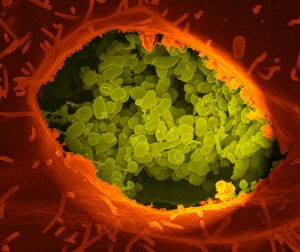
Taking the Query out of Q fever (i.e. the Q Fever Group) is a multidisciplinary initiative that brings together academic research groups, government agencies and livestock industry partners from Victoria, New South Wales, Queensland and South Australia. Funded by the Australian Government Department of Agriculture, Water and the Environment as part of its Rural R&D for Profit programme, with support from AgriFutures Australia as well as multiple university and industry partners, this multidisciplinary project’s overarching aim is to improve understanding of Coxiella burnetii reservoirs, amplification and transmission pathways within and outside Australian livestock holdings.
The University of Melbourne
- Faculty of Veterinary and Agricultural Sciences (Vet Epi @ Melbourne)
- Professor Mark Stevenson (Project Leader)
- Dr Bonny Cumming (Project Manager)
- Dr Simon Firestone
- Dr Anke Wiethoelter
 The University Queensland
The University Queensland
- School of Veterinary Science (UQ Spatial Epidemiology Laboratory)
- Associate Professor Ricardo Soares Magalhães
- Dr Tatiana Proboste Ibertti
- Dr Nicholas Clark
The University of Adelaide
Charles Sturt University
Australian Rickettsial Reference Laboratory
- Associate Professor John Stenos
- Dr Gemma Vincent
- Professor Stephen Graves
Meredith Dairy
- Dr Sandy & Julie Cameron
Goat Veterinary Consultancies
- Dr Sandra Baxendell
Other Partners of the Q Fever Group
The project also welcomes generous support from NSW Department of Primary Industries, the Victorian Department of Jobs, Precincts, and Resources, Biosecurity Queensland and Nuchev Pty Ltd.
Here you can find a broad range of other resources that we have found helpful for building a better understanding of Q fever, its causes and its impacts in the community. Please feel free to contact us if you come across other important and relevant resources that you’d like us to share.
Click to scroll to section
Project Developed Resources
Audio/visual resources
Infographic resources
About vaccination and the Q Fever Register
Other Fact sheets about Q fever prevention
Project Developed Resources
Q Fever Factsheet
Informative Q fever Prevention booklet for livestock handlers, developed by the Taking the Q (Query) Out of Q Fever Research/Industry Partnership:
Project Final Report
Comprehensive report detailing the findings over the life of the project (2018 – 2022).

Project Research Findings Factsheets
Brief factsheets summarising the findings under each of the various themes of research undertaken by the project.




Q Fever: Impacts in dairy goat herds - Download a pdf copy here
Q Fever in wildlife and pests - Download a pdf copy here
Environmental spread of Q fever - Download a pdf copy here
Guidelines for collaborative management of zoonotic diseases - Download a pdf copy here
Starting a One Health Conversation on Q Fever – informative video
This short video, developed in collaboration with CSL Seqirus and hosted on their page Q Fever Facts features Dr. Bonny Cumming, an Australian vet and Project Manager for this project. Dr. Cumming explores the vital connection between the environment, animals, and humans, emphasising how the Q fever bacteria spreads, and introduces the One Health concept.
Q Fever Literature Review
A compilation of all of the literature reviewed undertaken by the PhD students involved with the Taking the Q out of Q Fever project, resulting in a comprehensive review of the Q Fever and coxiellosis literature.
Audio/visual resources on Q fever
Q fever infographics
About vaccination and the Australian Q Fever Register
The Australian Q Fever Register
Other fact sheets about Q fever prevention
Here you can see the latest outputs from our research and engagement as well as other works that have been published by members of the Q Fever Group. Please feel free to contact us if you require access to publication full texts.
Click to scroll to section
Other Publications
2024
Tan, T., Heller, J., Firestone, S., Stevenson, M., & Wiethoelter, A. (2024). A systematic review of global Q fever outbreaks. One Health, 18, 100667. DOI: 10.1016/j.onehlt.2023.100667
2023
Voss, L., Huaman, J., Pacioni, C., Tolpinrud, A., Helbig, K., Carvalho, T. G., & Firestone, S. M. (2023). Seroprevalence of Coxiella burnetii antibodies in wild deer populations in eastern Australia. Australian veterinary journal, 101(3), 106-114. DOI: 10.1111/avj.13223
Hou, K., Firestone, S.M., Stevenson, M. (2023). Scenario tree modelling to inform surveillance design for maintaining freedom from Coxiella burnetii infection in Australian commercial dairy goat herds. Preventative Veterinary Medicine, DOI: 10.1016/j.prevetmed.2023.106024.
2022
Hou, K., Wiethoelter, A., Stevenson, M., Soares Magalhaes, R., Lignereux, L., Caraguel, C., … Firestone, S. (2022). A cross-sectional survey of risk factors for the presence of Coxiella burnetii in Australian commercial dairy goat farms. Australian Veterinary Journal, 100(7), pp. 296-305. DOI: 10.1111/avj.13163
Tolpinrud, A., Stenos, J., Chaber, A., Devlin, J. M., Herbert, C., Pas, A., … Firestone, S. M. (2022). Validation of an Indirect Immunofluorescence Assay and Commercial Q Fever Enzyme-Linked Immunosorbent Assay for Use in Macropods. Journal of Clinical Microbiology, 60(7), pp. 12-. DOI: 10.1128/jcm.00236-22
Proboste T., Clark N.J., Tozer S., Wood C., Lambert S.B., Soares Magalhães R.J. (2022). Profiling Risk Factors for Household and Community Spatiotemporal Clusters of Q Fever Notifications in Queensland between 2002 and 2017. Pathogens, 11(8):830. DOI: 10.3390/pathogens11080830
Abeykoon, A. H., Poon, M., Firestone, S. M., Stevenson, M. A., Wiethoelter, A. K. & Vincent, G. A. (2022). Performance Evaluation and Validation of Air Samplers To Detect Aerosolized Coxiella burnetii. Microbiology Spectrum, pp. 11-. DOI: 10.1128/spectrum.00655-22
Voss, L., Huaman, J., Pacioni, C., Tolpinrud, A., Helbig, K., Carvalho, T. & Firestone, S. (2022). Seroprevalence of Coxiella burnetii antibodies in wild deer populations in eastern Australia. Australian Veterinary Journal, pp. 9- DOI:. 10.1111/avj.13223
Tan, T. S. E., Hernandez‐Jover, M., Hayes, L. M., Wiethoelter, A. K., Firestone, S. M., Stevenson, M. A., & Heller, J. (2022). Identifying scenarios and risk factors for Q fever outbreaks using qualitative analysis of expert opinion. Zoonoses and Public Health. DOI: 10.1111/zph.12923
Gardner, B.R., Stenos, J., Hufschmid, J., Arnould, J.P., McIntosh, R.R., Tadepalli, M., Tolpinrud, A., Marenda, M., Lynch, M. and Stent, A. (2022). An old pathogen in a new environment–implications of Coxiella burnetii in Australian fur seals (Arctocephalus pusillus doriferos). Frontiers in Marine Science, p.6. DOI: 10.3389/fmars.2022.809075
2021
Wood, CM, Perkins, NR, Tozer, SJ, Johnson, W, Barnes, TS, McGowan, M, Gibson, JS, Alawneh, J, Firestone, SM, & Woldeyohannes, SM (2021). Prevalence and spatial distribution of Coxiella burnetii seropositivity in northern Australian beef cattle adjusted for diagnostic test uncertainty. Preventive Veterinary Medicine, 189, 105282. DOI: 10.1016/j.prevetmed.2021.105282
Proboste, T, Deressa, FB, Li, Y, Kal, DO, Gelalcha, BD, Soares Magalhães RJ (2021) Geographical Variation in Coxiella burnetii Seroprevalence in a Dairy Farm Located in South-Western Ethiopia: Understanding the Broader Community Risk. Pathogens, 10(6), 646. DOI: 10.3390/pathogens10060646
2020
Caraguel C, Bassett S, González-Barrio D, Elsworth P and Chaber A-L (2020). Comparison of three serological tests for the detection of Coxiella burnetii specific antibodies in European wild rabbits. BMC Veterinary Research, 16: 1-5. DOI: 10.1186/s12917-020-02526-w.
Abeykoon AMH, Clark NJ, Soares Magalhães RJ, Vincent GA, Stevenson MA, Firestone SM, Wiethoelter A (2020) Coxiella burnetii in the environment: A systematic review and critical appraisal of sampling methods. Zoonoses and Public Health DOI: 10.1111/zph.12791.
Clark, N.J., Tozer, S., Wood, C., Firestone, S.M., Stevenson, M., Caraguel, C., Chaber, A-L, Heller, J., Soares Magalhães, R.J.(2020) Unravelling animal exposure profiles of human Q fever cases in Queensland, Australia, using natural language processing. Transbound Emerg Dis. 00:1-13. DOI: 10.1111/tbed.13565
Canevari, JT (2020) Q fever in intensively managed dairy goats: Transmission dynamics, production losses and control interventions, PhD thesis. https://minerva-access.unimelb.edu.au/items/fd18c7f9-dfca-5259-af40-6d51539d9ede
2019
Wood, C., Muleme, M., Tan, T., Bosward, K., Gibson, J., Alawneh, J., McGowan, M., Barnes, T.S., Stenos, J., Perkins, N., Firestone, S.M. & Tozer, S. (2019) Validation of an indirect immunofluorescence assay (IFA) for the detection of IgG antibodies against Coxiella burnetii in bovine serum. Prev. Vet. Med., 169, 104698.
Clark, N.J., Caraguel, C., Heller, J., Soares Magalhães, R.J. and Firestone, S. Australia’s drought could be increasing Q fever risk, but there are ways we can protect ourselves. The Conversation. March 12, 2019.
2018
Canevari, J.T., Firestone, S.M., Vincent, G., Campbell, A., Tan, T., Muleme, M., Cameron, A.W.N. & Stevenson, M.A., 2018. The prevalence of Coxiella burnetii shedding in dairy goats at the time of parturition in an endemically infected enterprise and associated milk yield losses. BMC Vet. Res. 14(1):353.
Bond, K.A., Franklin, L., Sutton, B., Stevenson, M.A., Firestone, S.M., 2018. A review of 20 years of human acute Q Fever notifications in Victoria, 1994-2013. Aust. Vet. J. 96:223-230.
Clark N., Soares Magalhães R.J., 2018. Airborne geographical dispersal of Q Fever from livestock holdings to human communities: a systematic review and critical appraisal of evidence. BMC Infect. Dis. doi: 10.1186/s12879-018-3135-4.
2017
Bond, K.A., Franklin, L.J., Sutton, B., Firestone, S.M., 2017. Q-Vax Q fever vaccine failures, Victoria, Australia 1994–2013. Vaccine 35, 7084-7087. DOI: 10.1016/j.vaccine.2017.10.088
Muleme (2017) Coxiella burnetii infections in intensively-managed dairy goats: elucidation of transmission dynamics and vaccination strategies, PhD thesis. https://minerva-access.unimelb.edu.au/handle/11343/197548
Muleme, M., Stenos, J., Vincent, G., Wilks, C.R., Devlin, J.M., Campbell, A., Cameron, A., Stevenson, M.A., Graves, S., Firestone, S.M., 2017. Peripartum dynamics of Coxiella burnetii infections in intensively managed dairy goats associated with a Q fever outbreak in Australia. Prev. Vet. Med. 139, 58-66.
2016
Muleme, M., Stenos, J., Vincent, G., Campbell, A., Graves, S., Warner, S., Devlin, J.M., Nguyen, C., Stevenson, M.A., Wilks, C.R., Firestone, S.M., 2016. Bayesian validation of the indirect immuno-fluorescence assay and its superiority to the enzyme-linked immunosorbent assay and complement fixation test for detecting antibodies against Coxiella burnetii in goat serum. Clin. Vaccine Immunol., CVI. 00724-00715.
2015
Stevenson, M.A., Firestone, S.M., 2015. Veterinary epidemiology and ‘One Health’ in Australasia. Aust. Epidemiol. 22, 35-38.
Bond, K.A., Vincent, G., Wilks, C.R., Franklin, L., Sutton, B., Stenos, J., Cowan, R., Lim, K., Athan, E., Harris, O., Macfarlane-Berry, L., Segal, Y., Firestone, S.M., 2015. One Health approach to controlling a Q fever outbreak on an Australian goat farm. Epidemiol. Infect., 1-13.
Other Q Fever Group Member Publications
Simon Firestone (https://scholar.google.com.au/citations?user=z9_YatsAAAAJ&hl=en&oi=sra)
John Stenos (https://scholar.google.com.au/citations?user=_bobtt0AAAAJ&hl=en&oi=sra)
Ricardo Soares Magalhães (https://scholar.google.com.au/citations?user=aAh0t1AAAAAJ&hl=en)
Nicholas Clark (https://scholar.google.com.au/citations?user=5bO9uxEAAAAJ&hl=en)
Charles Caraguel (https://scholar.google.com.au/citations?user=X2131y0AAAAJ&hl=en&oi=ao)
Jane Heller (https://scholar.google.com.au/citations?user=JZA_jFYAAAAJ&hl=en&oi=ao)
Contacts and Media Enquiries
Dr Bonny Cumming, Project Manager
The University of Melbourne, Victoria 3010 Australia
E: bonny.cumming@unimelb.edu.a
Linked-in Group: Q Fever Researchers Australia

